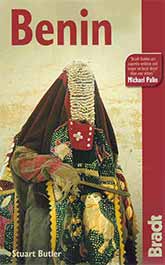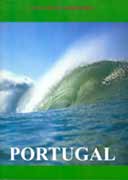


I
Surf magical
waves in the land of voodoo.

The 'Oceansurf Guidebooks' surf guide to PORTUGAL from Oceansurf Publications.
Everything you could ever need to know for a surf trip to Portugal.
Oceansurf is proud to be supported by C-SKINS wetsuits.
BEYOND THE GATESThis story first appeared
in 'Japanese Surfing World' magazine in 2005
The sun beats down and once again the wind blows with force, whipping up dust and rubbish and scattering it across the streets. Sometimes the wind can stay like this, day and night, for weeks on end, eventually, so it’s said, it will sap you of your sanity. I could certainly feel mine going, I’d been here for a few days now and the atmosphere of the place was dragging me down. I don’t know what it was, I’d just been expecting so much more than the drab streets of this rundown town, inhabited by a people, who to me anyway, appeared to be about to give it all up. And the statistics backed my thoughts up – this region has the highest suicide rate in the country. Some kids passed me by, kicking
an old Pepsi can in front of them, I watched them walk off round a corner
and then let my mind drift away from Barbate and its drugs, smugglers
and mafia bosses and return instead to the views I’d seen that
morning from the top of the cliffs that had brought me here in the first
place. Few places can stir the imagination quite like the cliffs above
Tarifa, for off these wind blown ledges four worlds collide, ancient
and modern. In front of you, and it seems within touching distance,
is Africa, to the east, the old world of the Mediterranean and to the
west the Atlantic and the launch pad to the Americas. But it’s
Spain, where I now stood, that had captivated me, it’s a place
that defies all attempts at categorisation and contains And it’s this that I had come to see. Andalucía is surely the birthplace of the Spanish imagination. It’s the home of Flamenco and bullfights, fiestas and sherry, and for many people it’s also the Spain of disappointment. Each year thousands of north Europeans see no more than a tatty Costa hotel block, whilst from just a few short miles away come the disenchanted of Africa, willing to risk everything and frequently loosing it all in a desperate journey across a continent to escape from a hell that is beyond our comprehension. Every day the body count mounts up as the bloated corpses of those who fell at the last hurdle are washed up onto the beaches of the Costa’s and quietly whipped away before the smells of frying food brings the holidaying masses out of their concrete bunker hotels. This definitely wasn’t what I’d been expecting too find when, just a few days ago, I’d left home and driven south, under the misguided impression that if I could figure out Andalucía then everything else about Spain would fall perfectly into place. After all Andalucía is where all the Spanish clichés begin. Surfing is, I think, a great way to get to know a place. It takes you to areas of a country that you wouldn’t normally visit and this was a classic example. Andalucía is for many people the epitome of all that is bad about mass tourism, sure its brought unprecedented wealth to what was once one of Spain’s poorest regions, but the downside has been the almost complete destruction of the natural coastal environment and the swamping of the local culture under fish and chip shops and tourist tack. And for many people this is all they see of Andalucía, but surfing was revealing another side of the province to me, a much quieter Andalucía, a much more traditionally Spanish Andalucía. The winds that blow with enough vengeance around the town of Tarifa to turn people mad have at least one silver lining to them, and that’s the relative absence of tourists. The Costa de la Luz is the aptly named stretch of coastline extending from the gates of the Mediterranean to the frontier of Portugal and it’s a world away from the hotel complexes of Torremolinos. As its name suggests, this coastline has a near luminous year round light and ample room to breathe and aside from the clustered groups of windsurfers around Tarifa the beaches are largely empty of foreigners. The hard winds, cool Atlantic waters, military bases and a ban on resort development has prevented all but the most determined of the holidaying hordes from passing through the gates. In fact it didn’t take
long for me to realise that the town of Barbate is one of the only places
on this coast that actually is worth avoiding, don’t get me wrong
though, it’s still a fascinating place to visit, it’s just
that Barbate has a dark secret that makes it a less than ideal holiday
spot. For it is here that one of the biggest issues facing Europe today
comes struggling up the beaches every morning and forces every single
European to examine their values, morals and opinions. Barbate is a
smuggling centre, but it’s not just the obvious Moroccan hash that
comes through this little town, Barbate is the centre of the people
smuggling trade, a trade that experts estimate has After some days I exchanged
depressing Barbate and the flapping windsurf sails of Tarifa for a beach
further to the north, the wind was less fierce up here and the beach,
El Palmar, had an air to it that was both wild yet beautiful. El Palmar
forms the heart of Andalucían surfing, it’s about the most
consistent wave on the Costa de la Luz and is a popular spot with the
local surf crews with the weekends getting pretty busy as everyone chases
after one of the playful, sandy tubes. If you want to get away from
the crowds altogether then pick up your board and walk southwards, away
from the main beach car park and down towards the cape, off which Lord
Nelson won a war, but lost his life, and you’ll pass by a dozen
empty peaks. The nearest town to El Palmar is The swell hung around for
a few days whilst I was in Conil, at first it was just small and clean,
ideal conditions for fun waves at El Palmar. Slowly though the swell
begun to build and with the increasing swell came increasing opportunities.
On the biggest day of the trip I was given a choice between a slightly
bumpy but solid reef break to the south of Conil or a long and soothing
right point. Beyond these are other waves, shore break wedges, hollow
reefs and a very rare river mouth left with miniature pretensions of
its more famous Basque cousin. On the whole though, the general feature
of this coast is of long beaches and largely deserted waves. These beaches
continue right up to the walls of Cádiz, Spain’s oldest
city, and onwards through the Donãna National Park, a vast area
of sand dunes and marshes whose in-accessibility keeps almost everyone
out, but certainly hides plenty of waves. For me though, as the swell
peaked and then begun to fade away again, I moved - for my final Andalucían
days - into Cádiz, Thanks to Andy at Winterwaves, www.winterwaves.co.uk, in Conil and Wes at Pure Vacations, www.purevacations.com, for their input and generosity in both putting together this article and their help with compiling the Andalucía section of the new Oceansurf Guidebook: Spain, www.oceansurfpublications.co.uk, from which much of the information and inspiration contained within this article comes. {main page} |